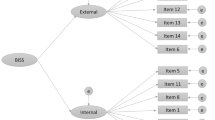Abstract
Previous research has suggested a role for bodily shame in the development of bulimia. The purpose of the present study was to extend this research by exploring a temporal perspective on bodily shame and eating pathology. Specifically, we were interested in whether bodily shame associated with the possibility of future weight gain was important in determining eating disorder symptoms independently of any association with bodily shame associated with current body size. A brief questionnaire designed to measure bodily shame was developed for the purposes of this study and administered to four samples (total n=428) of eating disordered and non-eating disordered women who also completed a number of measures of eating pathology. Factor analysis of the bodily shame scale identified three sub-scales, two measuring feelings of bodily shame (one measuring shame associated with current body size and one measuring shame that is anticipated should the individual gain weight) and a third measuring the perceived unattractiveness of being overweight. Anticipated bodily shame made a significant additional contribution to predicting eating disorder symptoms over and above that made by current bodily shame. A focus on feelings of bodily shame as they are currently experienced may limit the usefulness of this construct in eating disorder research. Since shame can be both punishing and prohibitive, consideration of the anticipation of shame as a consequence of weight gain may be a useful addition to understanding eating disordered behaviours, particularly in relation to symptoms concerning the prevention of weight gain rather than just the achievement of weight loss.
Similar content being viewed by others
References
Lewis M.: Self-conscious emotions: Embarrassment, pride, shame and guilt In: Lewis M., Haviland J.M. (Eds.), Handbook of emotions. New York, Guilford Press, 1993, pp. 563–574.
Power M., Dagleish T.: Emotion: From order to disorder. Hove, Psychology Press, 1997.
Tangney J.P.: Shame and guilt. In: Costello C.G. (Ed.), Symptoms of depression. New York, Wiley, 1993, pp. 161–180.
Gilbert P.: What is shame? In: Gilbert P., Andrews B. (Eds.), Shame: Interpersonal behaviour, psychopathology and culture. New York, Oxford University Press, 1998, pp. 3–38.
Gilbert P.: Depression: The evolution of powerlessness. Hove, LEA, 1992.
Strongman K.T.: The psychology of emotion, 4th ed. Theories of emotion in perspective. Chichester, Wiley, 1996.
Gilbert P.: The evolution of social attractiveness and its role in shame, humiliation, guilt and therapy. Br. J. Med. Psychol., 70, 113–147, 1997.
Sanftner J.L., Barlow D.H., Marschall D.E., Tangney J.P.: The relation of shame and guilt to eating disorder symptomatology. J. Soc. Clin. Psychol., 14, 315–324, 1995.
Gee A., Troop N.A.: Shame, depressive symptoms and eating, weight and shape concerns in a non-clinical sample. Eat. Weight Disord., 8, 72–75, 2003.
Murray C., Waller G., Legg C.: Family dysfunction and bulimic psychopathology: The mediating role of shame. Int. J. Eat. Disord., 28, 84–89, 2000.
Frank E.S.: Shame and guilt in eating disorders. Am. J. Orthopsychiatr., 61, 303–306, 1991.
Andrews B.: Bodily shame in relation to abuse in childhood and bulimia: A preliminary investigation. Br. J. Clin. Psychol., 36, 41–49, 1997.
Burney J., Irwin H.J.: Shame and guilt in women with eating disorder symptomatology. J. Clin. Psychol., 56, 51–61, 2000.
Andrews B.: Bodily shame as a mediator between abusive experiences and depression. J. Abnorm. Psychol., 104, 277–285, 1995.
Andrews B., Qian M., Valentine J.D.: Predicting depressive symptoms with a new measure of shame: The Experience of Shame Scale. Br. J. Clin. Psychol., 41, 29–42, 2002.
McKinley N.M., Hyde J.S.: The Objectified Body Consciousness Scale: Development and validation. Psychol. Women, 20, 181–215, 1996.
McFarland B., Baker-Baumann T.: Shame and body image: Culture and the compulsive eater. Deerfield Beach, FLA, Health Communications, 1990.
Andrews B.: Methodological and definitional issues in shame research. In: Gilbert P., Andrews B. (Eds.), Shame: Interpersonal behaviour, psychopathology and culture. New York, Oxford University Press, 1998, pp. 39–54.
Macdonald J., Morley I.: Shame and non-disclosure: A study of the emotional isolation of people referred for psychotherapy. Br. J. Med. Psychol., 74, 1–21, 2001.
Tangney J.P.: Recent advances in the empirical study of shame and guilt. Am. Behav. Sci., 38, 1132–1145, 1995.
Miller W.I.: The anatomy of disgust. Cambridge, MA, Harvard, 1997.
Russell G.F.M.: Anorexia nervosa through time. In: Szmukler G., Dare C., Treasure J. (Eds.), Handbook of eating disorders: Theory, treatment and research. Chichester, Wiley, 1995, pp. 5–17.
Harder D.W., Zalma A.: Two promising shame and guilt scales: A construct validity comparison. J. Person. Assess., 55, 729–745, 1990.
Bauer S., Winn S., Schmidt U.H., Kordy H.: Construction, scoring and validation of the Short Evaluation for Eating Disorders (SEED). Eur. Eat. Disord. Rev., 13, 191–200, 2005.
Kordy H., COST Action B6: Counting the COST: A European collaboration on the efficiency of psychotherapeutic treatment of patients with eating disorders. Eur. Eat. Disord. Rev., 13, 153–158, 2005.
American Psychiatric Association: Diagnostic and statistical manual of mental disorders, 4th ed. Washington D.C., APA, 1994.
Andrews B., Hunter E.: Shame, early abuse and course of depression in a clinical sample: A preliminary sample. Cog. Em., 11, 373–381, 1997.
Cooper M., Cohen-Tovée E., Todd G., Wells A., Tovée M.: The Eating Disorder Beliefs Questionnaire: Preliminary development. Behav. Res. Ther., 35, 381–388, 1997
Author information
Authors and Affiliations
Corresponding author
Rights and permissions
About this article
Cite this article
Troop, N.A., Sotrilli, S., Serpell, L. et al. Establishing a useful distinction between current and anticipated bodily shame in eating disorders. Eat Weight Disord 11, 83–90 (2006). https://doi.org/10.1007/BF03327756
Received:
Accepted:
Published:
Issue Date:
DOI: https://doi.org/10.1007/BF03327756




